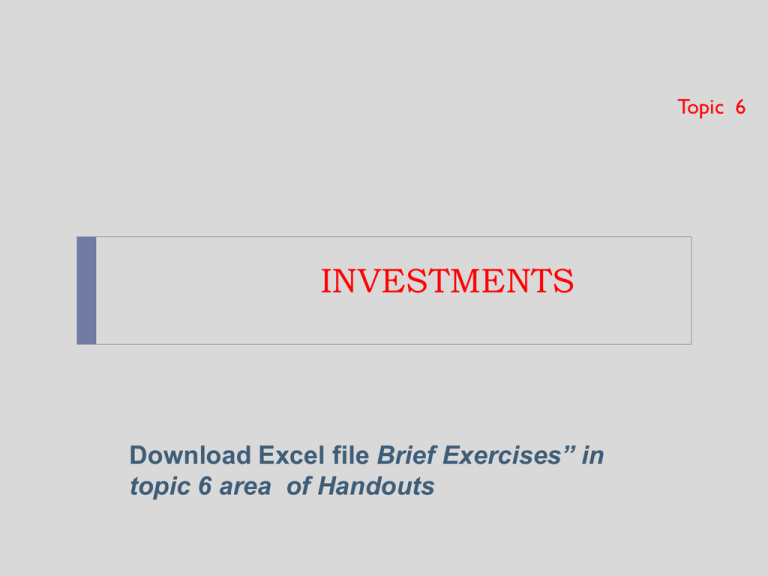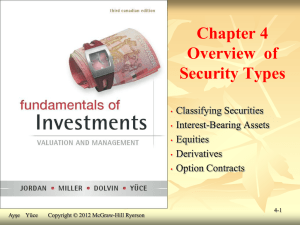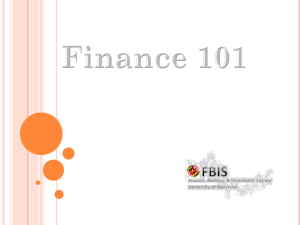Investment Accounting: HTM, Trading, AFS Securities
advertisement

Topic 6 INVESTMENTS Download Excel file Brief Exercises” in topic 6 area of Handouts 12-2 Nature of Investments Bonds and notes (Debt securities) Common and preferred stock (Equity securities) Investments can be accounted for in a variety of ways, depending on the nature of the investment relationship. 12-3 Reporting Categories for Investments Reporting Categories for Investments Control Characteristics of the Investment Reporting Method Used by the Investor The investor lacks significant influence over the operating and financial policies of the investee: Investment in debt securities for which the investor Held-to-maturity (HTM) - investment reported at has the "positive intent and ability" to hold to amortized cost.* maturity. Trading securities (TS) - investment reported at fair Investment held in an active trading account. value with unrealized holding gains and losses included in net income. Securities available-for-sale (AFS) - investment reported at fair value with unrealized holding gains and Other. losses excluded from net income and reported in other comprehensive income.* The investor has significant influence over the operating and financial policies of the investee: Typically the investor owns between 20% and 50% Equity method - investment cost adjusted for of the voting stock of the investee. subsequent earnings and dividends of the investee.* The investor controls the investee: The investor owns more than 50% of the voting Consolidation - the financial statements of the investor stock of the investee. and investee are combined as if they are a single company. * If the investor elects the fair value option , this type of investment also can be accounted for using the same approach that's used for trading securities, with the investment reported at fair value and unrealized holding gains and losses included in earnings. 12-4 Investor Lacks Significant Influence Reporting Approach Held-to-maturity (HTM): used for debt that is planned to be held for its entire life Treatment of Unrealized Holding Gains and Losses Not recognized Investment Reported in the Balance Sheet at Amortized Cost Trading (TS): used for debt or equity that is held in an active trading account for immediate resale, or for which the fair value option had been elected. Recognized in net income and therefore in retained earnings as part of stockholders' equity Fair Value Available-for-sale (AFS): used for debt or equity that does not qualify as held-to-maturity or trading. Recognized in other comprehensive income, and therefore in accumulated other comprehensive income in shareholders' equity Fair Value 12-5 Securities to Be Held to Maturity Securities are investments in bonds or other debt security that have a specified maturity date. The bonds or other debt are initially recorded at cost. The investor may have the “positive intent and ability” to hold the securities to maturity and can therefore be classified as held-to-maturity (HTM). They are reported on the balance sheet at “amortized cost.” Amortized cost (Face amount less unamortized discount, or plus unamortized premium). Balance Sheet 12-6 Securities to Be Held to Maturity On January 1, 2013, Matrix Inc. purchased as an investment $1,000,000, of 10%, 10-year bonds, interest paid semiannually. The market rate for similar bonds is 12%. Let’s look at the calculation of the present value of the bond issue. Present Amount PV Factor Value Interest $ 50,000 × 11.46992 = $573,496 Principal 1,000,000 × 0.31180 = 311,805 Present value of bonds $885,301 PV of ordinary annuity of $1, n = 20, i = 6% PV of $1, n = 20, i = 6% 12-7 Securities to Be Held to Maturity Partial Bond Amortization Table Date 1/1/13 6/30/13 12/31/13 6/30/14 12/31/14 Interest Payment $ 50,000 50,000 50,000 50,000 Interest Revenue $ 53,118 53,305 53,503 53,714 Discount Amortization $ January 1, 2013 Investment in bonds Discount on bond investment Cash June 30, 2013 Cash (stated rate × face amount) Discount on bond investment Investment revenue 3,118 3,305 3,503 3,714 Unamortized Discount $ 114,699 111,581 108,276 104,772 101,059 Carrying Value $ 885,301 888,419 891,724 895,228 898,941 1,000,000 114,699 885,301 50,000 3,118 53,118 12-8 Securities to Be Held to Maturity This investment would appear on the June 30, 2013, balance sheet as follows: June 30, 2013 Investment in bonds Less: Discount on bond investment Book value (amortized cost) $ 1,000,000 111,581 $ 888,419 $114,699 - $3,118 = $111,581 unamortized discount Unrealized holding gains and losses are not recognized for HTM investments. 12-9 Securities to Be Held to Maturity On December 31, 2013, after interest is received by Matrix, all the bonds are sold for $900,000 cash. Date 1/1/13 6/30/13 12/31/13 6/30/14 12/31/14 Interest Payment $ 50,000 50,000 50,000 50,000 Interest Revenue $ 53,118 53,305 53,503 53,714 December 31, 2013 Cash Discount on bond investment Investment revenue Discount Amortization $ 3,118 3,305 3,503 3,714 Unamortized Discount $ 114,699 111,581 108,276 104,772 101,059 50,000 3,305 December 31, 2013 Cash 900,000 Discount on bond investment 108,276 Investment in bonds Gain on sale of investment 53,305 1,000,000 8,276 Carrying Value $ 885,301 888,419 891,724 895,228 898,941 12-10 Brief Exercise 12-1 Lance Brothers Enterprises acquired $720,000 of 3% bonds, dated July 1, on July 1, 2013, as a long-term investment. Management has the positive intent and ability to hold the bonds until maturity. The market interest rate (yield) was 4% for bonds of similar risk and maturity. Lance Brothers paid $600,000 for the investment in bonds and will receive interest semiannually on June 30 and December 31. Prepare the journal entries (a) to record Lance Brothers’ investment in the bonds on July 1, 2013, and (b) to record interest on December 31, 2013, using the effective (market) rate method. 12-11 Trading Securities Investments in debt or equity securities acquired principally for the purpose of selling them in the near term. Adjustments to fair value are recorded 1. in a valuation account called fair value adjustment, or as a direct adjustment to the investment account. 2. as a net unrealized holding gain/loss on the income statement. Unrealized Gain Unrealized Loss Income Statement 12-12 Trading Securities Matrix Inc. purchased securities classified as Trading Securities (TS) on December 22, 2013. The fair value amounts for these securities on December 31, 2013, are shown below. Prepare the journal entries for Matrix Inc. to show the purchase of the securities, and adjust the securities to fair value at 12/31/13. Type TS TS Name Mining Inc Toys and Things Totals No. of Shares 1,000 1,500 12/22/13 12/31/13 Unrealized Unit Total Fair Gain or Cost Cost Value (Loss) $ 42.00 $ 42,000 $ 41,000 $ (1,000) 15.00 22,500 20,000 (2,500) $ 64,500 $ 61,000 $ (3,500) 12-13 Trading Securities December 22, 2013 Investment in Mining Inc. stock Investment in Toys and Things stock Cash Security Cost 42,000 22,500 64,500 Fair Value Adjustment Mining Inc $ 42,000 $ 41,000 Toys and Things 22,500 20,000 Total $ 64,500 $ 61,000 Existing balance in fair value adjustment Change needed in fair value adjustment $ (1,000) (2,500) $ (3,500) -0$ (3,500) Reported on the balance sheet as a adjunct account to the investment. December 31, 2013 Net unrealized holding gains and losses – I/S Fair value adjustment The Net Unrealized Holding Loss is reported on the Income Statement. 3,500 3,500 12-14 Trading Securities On January 3, 2014, Matrix sold all trading securities for $65,000 cash. Let’s record the entry for the sale and the adjustment to the fair value adjustment account. January 3, 2014 Cash Investment in Mining, Inc. stock – T/S Investment in Toys and Things stock – T/S Gain on sale of investment December 31, 2014 Fair value adjustment Net unrealized holding gains or losses – I/S 65,000 42,000 22,500 500 3,500 3,500 12-15 Financial Statement Presentation Trading securities are presented on the financial statement as follows: 1. Income Statement and Statement of Comprehensive Income: Fair value changes are included in the income statement in the periods in which they occur, regardless of whether they are realized or unrealized. Investments in trading securities do not affect other comprehensive income. 2. Balance Sheet: Securities are reported at fair value, typically as current assets, and do not affect accumulated other comprehensive income in shareholders’ equity. 3. Cash Flow Statement: Cash flows from buying and selling trading securities typically are classified as operating activities, because the investors that hold trading securities consider them as part of their normal operations. 12-16 Financial Statement Presentation Presented below are the partial financial statements showing the accounting for TS owned by Matrix: Income Statement Revenue Expenses Other income (expenses): Gain on sale of investment Realized and unrealized gains and losses on investments Total expenses Net income Balance Sheet Assets: Trading securities Statement of Cash Flows (direct method) Operating Activities: Cash from investment revenue Purchase of trading securities Sale of trading securities 2013 2014 t t t t t (3,500) t t 500 3,500 t t 61,000 -0- -0(64,500) -0- -0-065,000 12-17 Securities Available-for-Sale Investments in debt or equity securities that are not for active trading and not to be held to maturity are classified as available-for-sale (AFS). Adjustments to fair value are recorded 1. in a valuation account called fair value adjustment, or as a direct adjustment to the investment account. 2. as a net unrealized holding gain/loss in other comprehensive income (OCI), which accumulates in accumulated other comprehensive income (ACOI). Unrealized Gain Unrealized Loss Other Comprehensive Income (OCI) 12-18 Other Comprehensive Income (OCI) Other comprehensive income: Foreign currency translation gains (losses) Net unrealized holding gains (losses) on investments Minimum pension liability adjustment Deferred gains (losses) from derivatives Less: aggregate income tax expense (benefit) Other comprehensive income $ XX,XXX -12,500 XXX XXX $ XX,XXX X,XXX $ XX,XXX When we add other comprehensive income to net income we refer to the result as “comprehensive income.” Accumulated Other Comprehensive Income Unrealized holding gains and losses on availablefor-sale securities are accumulated in the shareholders’ equity section of the balance sheet. Specifically, the account is included in accumulated other comprehensive income (AOCI). Net unrealized holding gains and losses. Shareholders’ Equity Common stock Paid-in capital in excess of par Accumulated other comprehensive income Retained earnings Total shareholders’ equity 12-19 12-20 Securities Available for Sale Example Assume the same information for our T/S example for Matrix Inc., except that the investments are classified as available-for-sale securities rather than trading securities. Security Cost Fair Value Adjustment Mining Inc $ 42,000 $ 41,000 Toys and Things 22,500 20,000 Total $ 64,500 $ 61,000 Existing balance in fair value adjustment Change needed $ (1,000) (2,500) $ (3,500) -0$ (3,500) December 31, 2013 Net unrealized holding gains and losses – OCI Fair value adjustment 3,500 3,500 12-21 Financial Statement Presentation AFS securities are presented on the financial statement as follows: 1. Income Statement and Statement of Comprehensive Income: Realized gains and losses are shown in net income in the period in which securities are sold. Unrealized gains and losses are shown in OCI in the periods in which changes in fair value occur, and reclassified out of OCI in the periods in which securities are sold. 2. Balance Sheet: Investments in AFS securities are reported at fair value. Unrealized gains and losses affect AOCI in shareholders’ equity, and are reclassified out of AOCI in the periods in which securities are sold. 3. Cash Flow Statement: Cash flows from buying and selling AFS securities typically are classified as investing activities. 12-22 Brief Exercise 12-2 S&L Financial buys and sells securities expecting to earn profits on short-term differences in price. On December 27, 2013, S&L purchased Coca-Cola common shares for $875,000 and sold the shares on January 3, 2014, for $880,000. At December 31, the shares had a fair value of $873,000. What journal entries would S&L make in 2013 and 2014 as a result of this investment? 12-23 Brief Exercise 12-3 S&L Financial buys and sells securities with the intent of holding for an extended period of time. Since this is their intent all securities are reported as available for sale. On December 27, 2013, S&L purchased Coca-Cola common shares for $875,000 and sold the shares on January 3, 2014, for $880,000. At December 31, the shares had a fair value of $873,000. What journal entries would S&L make in 2013 and 2014 as a result of this investment? 12-24 Brief Exercise 12-2 & 12-3 For trading securities, unrealized holding gains and losses: are or are not included in earnings. For securities available-for-sale, unrealized holding gains and losses: are or are not included in earnings. 12-25 BE 12-4 For several years Fister Links Products has held shares of Microsoft common stock, considered by the company to be securities available-for-sale. The shares were acquired at a cost of $500,000. Their fair value last year was $610,000 and is $670,000 this year. At what amount will the investment be reported in this year’s balance sheet? What adjusting entry is required to accomplish this objective? 12-26 Transfers Between Reporting Categories Any unrealized holding gain or loss at reclassification should be accounted for in a manner consistent with the classification into which the security is being transferred. Securities are transferred at fair market value on the date of transfer. Unrealized Gain or Loss from Transfer from: To: Transfer at Fair Market Value Either of the other Trading Include in current net income the total unrealized gain or loss, as if it all occurred in the current period. Trading Either of the other Include in current net income any unrealized gain or loss that occurred in the current period prior to the transfer. (Unrealized gains and losses that occurred in prior periods already were included in net income in those periods.) Held-to-maturity Available-for-sale No current income effect. Report total unrealized Available-for-sale Held-to-maturity gain or loss as a separate component of shareholders’ equity (in AOCI No current income effect. Don’t write off any existing unrealized holding gain or loss in AOCI, but amortize it to net income over the remaining life of the security (fair value amount becomes the security’s amortized cost basis). Financial Statement Presentation and Disclosure Aggregate Fair Value Gross realized & unrealized holding gains & losses Maturities of debt securities Amortized cost basis by major security type Change in net unrealized holding gains and losses Inputs to fair value estimates 12-27 12-28 Impairment of Investments Occasionally, an investment’s value will decline for reasons that are other-thantemporary (OTT). For HTM and AFS investments, a company recognizes an impairment loss in earnings. Determining an “other than temporary” decline for debt securities can be quite complex. For both equity and debt investments, after an impairment is recognized, the ordinary treatment of unrealized gains and losses is resumed. 12-29 Brief Exercise 12-13 LED Corporation owns 100,000 shares of Branch Pharmaceuticals common stock and classifies its investment as securities available-for-sale. The market price of Branch’s stock fell over 30%, by $4.50 per share when the FDA banned one of the company’s principal drugs. What journal entry should LED record to account for the decline in market value? How should the decline be reported? 12-30 Investor Has Significant Influence Reporting Categories for Investments Control Characteristics of the Investment Reporting Method Used by the Investor The investor lacks significant influence over the operating and financial policies of the investee: Investment in debt securities for which the investor Held-to-maturity (HTM) - investment reported at has the "positive intent and ability" to hold to amortized cost.* maturity. Investment held in an active trading account. Trading securities (TS) - investment reported at fair value with unrealized holding gains and losses included in net income. Other. Securities available-for-sale (AFS) - investment reported at fair value with unrealized holding gains and losses excluded from net income and reported in Other Comprehensive income.* The investor has significant influence over the operating and financial policies of the investee: Typically the investor owns between 20% and 50% Equity method - investment cost adjusted for of the voting stock of the investee. subsequent earnings and dividends of the investee.* The investor controls the investee: The investor owns more than 50% of the voting Consolidation - the financial statements of the investor stock of the investee. and investee are combined as if they are a single company. * If the investor elects the fair value option, this type of investment also can be accounted for using the same approach that's used for trading securities, with the investment reported at fair value and unrealized holding gains and losses included in earnings. 12-31 Investor Has Significant Influence Extent of Investor Influence Lack of significant influence (usually < 20% equity ownership) Significant influence (usually 20% - 50% equity ownership) Has control (usually > 50% equity ownership) Reporting Method Varies depending on classification previously discussed Equity method Consolidation Criteria for Determining Whether There is Influence FASC Sec 323 Representation on the investee’s Board of Directors Participation in the investee’s policy-making process Material intercompany transactions. Interchange of managerial personnel. Technological dependency. Extent of ownership in relationship to other ownership percentages. 12-32 12-33 What Is Significant Influence? If an investor owns 20% of the voting stock of an investee, it is presumed that the investor has significant influence over the financial and operating policies of the investee. The presumption can be overcome if 1. the investee challenges the investor’s ability to exercise significant influence through litigation or other methods. 2. the investor surrenders significant shareholder rights in a signed agreement. 3. the investor is unable to acquire sufficient information about the investee to apply the equity method. 4. the investor tries and fails to obtain representation on the board of directors of the investee. 12-34 Equity Method 1. The investment account is increased by: 2. Original investment cost. Proportionate share of investee's earnings. The investment account is decreased by: Dividends received. 12-35 Equity Method The investment account is reported on the balance sheet as a single amount. The investor’s share of the investee’s earnings from date of acquisition is reported as a single item on the investor’s income statement. 12-36 Equity Method On January 1, 2013, Wilmer Inc. acquired 45% of the equity securities of Apex Inc. for $1,350,000. On the acquisition date, Apex’s net assets had a fair value of $3,000,000. During 2013, Apex paid cash dividends of $150,000 and reported net income of $1,750,000. What amount will Wilmer Inc. report on the balance sheet as Investment in Apex Inc. on December 31, 2013? 12-37 Equity Method January 1, 2013 Investment in Apex Inc. stock Cash 1,350,000 1,350,000 $ 3,000,000 Fair value of net assets × 45% Percentage ownership $ 1,350,000 Fair value of assets purchased 2013 Investment in Apex Inc. stock Investment revenue $ × $ 787,500 787,500 1,750,000 Reported earnings 45% Percentage ownership 787,500 Share of earnings 2013 Cash 67,500 Investment in Apex Inc. stock $ × $ 150,000 Dividends paid 45% Percentage ownership 67,500 Share of dividends 67,500 12-38 Equity Method Investment in Apex Inc. Investment 1,350,000 45% Earnings 787,500 67,500 45% Dividends Reported amount 2,070,000 If the investee had a loss, the investment account would have been reduced with a credit. 12-39 Equity Method On January 1, 2013, Wilmer Inc. purchased 25% of the common stock of Apex Inc. for $180,000. At the date of acquisition, the book value of the net assets of Apex was $400,000, and the fair value of these assets is $600,000. During 2013, Apex paid cash dividends of $40,000, and reported earnings of $100,000. Fair value of assets Percentage ownership Share of fair value of assets Cost of investment in Apex Excess of cost over fair value $ 600,000 25% 150,000 180,000 $ 30,000 12-40 Equity Method The excess of the fair value of net assets over book value of those net assets is 75% attributable to depreciable assets with a remaining life of 20 years and is 25% attributable to land. Wilmer uses the straight-line depreciation. Fair value of net assets $ 600,000 Book value of net assets 400,000 Difference 200,000 Percentage of net assets acquired × 25% Excess 50,000 Amount attributable to land (25% or excess) 12,500 Amount attributable to depreciable assets 37,500 Remaining life of depreciable assets 20 years Additional depreciation expense per year $ 1,875 12-41 Equity Method January 1, 2013 Investment in Apex stock Cash 2013 Cash 180,000 180,000 10,000 Investment in Apex stock Investment in Apex stock Investment revenue December 31, 2013 Investment revenue Investment in Apex stock $ 40,000 Dividends paid × 25% Percentage ownership $ 10,000 Share of dividends 10,000 25,000 25,000 1,875 1,875 $ 100,000 Reported earnings × 25% Percentage ownership $ 25,000 Share of earnings 12-42 Brief Ex 12-8 Turner Company owns 10% of the outstanding stock of ICA Company. During the current year, ICA paid turner a $500,000 cash dividend. What journal entry is made for the dividend Turner receives in the current year? 12-43 Brief Ex 12-8 Explanation Turner should account for the dividends as trading or available for sale investments, unless they have the ability to exercise significant influence, then Turner would account for the investment using the equity method as investment revenue. Since Turner holds only 10% of ICA stock, it’s assumed that it does not have significant influence over the company. 12-44 Brief Exercise 12-7 Turner Company owns 40% of the outstanding stock of ICA Company. During the current year, ICA paid a $2 million cash dividend to Turner. What journal entry is made for the dividend Turner receives in the current year? 12-45 Brief Exercise 12-7 Explanation Turner is presumed to have the ability to exercise significant influence over ICA based on the 40% ownership. Turner should account for ICA’s dividends as a reduction in its Investment in ICA account. Since investment revenue is recognized as ICA earns it, it would be inappropriate to again recognize revenue when earnings are distributed as dividends. Instead, the dividend distribution is considered to be a reduction of the investment in ICA’s net assets, reflecting the fact that the Turner’s ownership interest in those net assets declined proportionately. 12-46 Brief Ex 12-9 The fair value of Wallis, Inc.’s depreciable assets exceeds their book value by $50 million. The assets have an average remaining useful life of 15 years and are being depreciated by the straight-line method. Park Industries buys 30% of Wallis’s common shares. When Park adjusts its investment revenue and the investment by the equity method, what adjusting journal entry will be made? 12-47 Brief Ex 12-9 Explanation The equity method reports acquired net assets at their fair values. Both the accounts Equity Income and Investment in Wallis would be reduced by the “extra depreciation” the higher fair value. This would equal 30% x $50 million ÷ 15 years = ? each year for fifteen years. 12-48 End of Required Course Material The following will be covered in Advanced Accounting Will not be tested on final. 12-49 Fair Value Option GAAP allows companies to use a “fair value option” for HTM, AFS, and equity method investments. The investment is carried at fair value. Unrealized gains and losses are included in income. For HTM and AFS investments, this amounts to classifying the investments as trading. For equity method investments, the investment is still classified on the balance sheet with equity method investments, but the portion at fair value must be clearly indicated. The fair value option is determined for each individual investment, and is irrevocable. Financial Instruments and Investment Derivatives 12-50 Financial Instruments: Investment Derivatives: 1. Cash. 2. Evidence of an ownership interest in an entity. 3. Contracts meeting certain conditions. 1. Value is derived from other securities. 2. Derivatives are often used to “hedge” (offset) risks created by other investments or transactions







